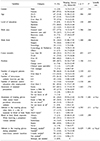Abstract
Background
This study purposed to analyze general hospital nurses' adherence to glove wearing on inserting peripheral intravenous catheter (PIC) and the difference factors.
Methods
This study was conducted as a cross-sectional self-reporting survey using a structured questionnaire developed by the researcher, and involved 230 nurses working at the wards, ICUs, and recovery rooms of six general hospitals in Seoul, Gangwon-do, and Ulsan. The survey was conducted for two months from June to July 2015.
Results
The mean adherence to glove wearing on inserting PIC was 10.5%, the rate of wearing glove was higher in nurses than that of 9 or more patients (t=2.319, P=.021), and the number of nurses who received infection control training was less than one (t=−3.518, P=.001). In addition, the rate of wearing glove was higher in nurses who know that they should wear gloves on insertion PIC (F=14.57, P<.001) and that they are required to wear loves when performing procedures at risk of exposure to blood or body fluids (F=4.59, P=.011) and to wear gloves when inserting a peripheral vein (F=16.03, P<.001).
Conclusion
In order to enhance nurses' adherence to glove wearing on inserting PIC, it is necessary to maintain the optimal ratio of nurses to patients, to execute active campaigns, to educate and to train nurses to recognize the importance and necessity of glove wearing and to change their attitude, and to develop and supply adequate gloves.
Figures and Tables
References
1. Cirelli MA, de Figueiredo RM, Zem-Mascarenhas SH. Adherence to standard precaution in the peripheral vascular access. Rev Lat Am Enfermagem. 2007; 15:512–514.

2. Mermel LA, Farr BM, Sherertz RJ, Raad II, O'Grady N, Harris JS, et al. Guidelines for the management of intravascular catheter-related infections. Infect Control Hosp Epidemiol. 2001; 22:222–242.

3. World Health Organization. Glove use information leaflet. Updated on August 2009. http://tinyurl.com/76hstt6.
4. Korea Centers for Disease Control and Prevention. Standards for Infection Control in Intensivecare unit. Updated on August 2010. http://www.cdc.go.kr/CDC/cms/cmsFileDownload.jsp?fid=3081&cid=25368&fieldName=attachGrp&index=2.
5. Joint Commission International. Joint Commission International accreditation standards for hospitals. Washington DC: Oakbrook Terrace, Joint Commission Resources;2002.
6. Naderi HR, Sheybani F, Mostafavi I, Khosravi N. Compliance with hand hygiene and glove change in a general hospital, Mashhad, Iran: an observational study. Am J Infect Control. 2012; 40:e221–e223.

7. Loveday HP, Lynam S, Singleton J, Wilson J. Clinical glove use: healthcare workers' actions and perceptions. J Hosp Infect. 2014; 86:110–116.

8. Bennett G, Mansell I. Universal precautions: a survey of community nurses' experience and practice. J Clin Nurs. 2004; 13:413–421.

9. Expert Advisory Group on AIDS, Advisory Group on Hepatitis. Great Britain. Department of Health. Guidance for clinical health care workers: protection against infection with blood-borne viruses : recommendations of the Expert Advisory Group on AIDS and the Advisory Group on Hepatitis. London: UK Health Department;1998.
11. Watson PWB, Myers LB. Which cognitive factors predict clinical glove use amongst nurses? Psychol Health Med. 2001; 6:399–409.

12. Ferguson KJ, Waitzkin H, Beekmann SE, Doebbeling BN. Critical incidents of non-adherence with standard precautions guidelines among community hospital-based health care workers. J Gen Intern Med. 2004; 19:726–731.

13. Kaczmarek RG, Moore RM Jr, McCrohan J, Arrowsmith-Lowe JT, Caquelin C, Reynolds C, et al. Glove use by health care workers: results of a tristate investigation. Am J Infect Control. 1991; 19:228–232.

14. You SJ. Policy implications of nurse staffing legislation. J Korea Contents Assoc. 2013; 13:380–389.

15. Cho SH, Song KJ, Park IS, Kim YH, Kim MS, Gong DH, et al. [Development of staffing levels for nursing personnel to provide inpatients with integrated nursing care]. J Korean Acad Nurs Adm. 2017; 23:211–222.

16. Kuzu N, Ozer F, Aydemir S, Yalcin AN, Zencir M. Compliance with hand hygiene and glove use in a university-affiliated hospital. Infect Control Hosp Epidemiol. 2005; 26:312–315.

17. DeGroot-Kosolcharoen J. Pandemonium over gloves: use and abuse. Am J Infect Control. 1991; 19:225–227.





 PDF
PDF ePub
ePub Citation
Citation Print
Print





 XML Download
XML Download